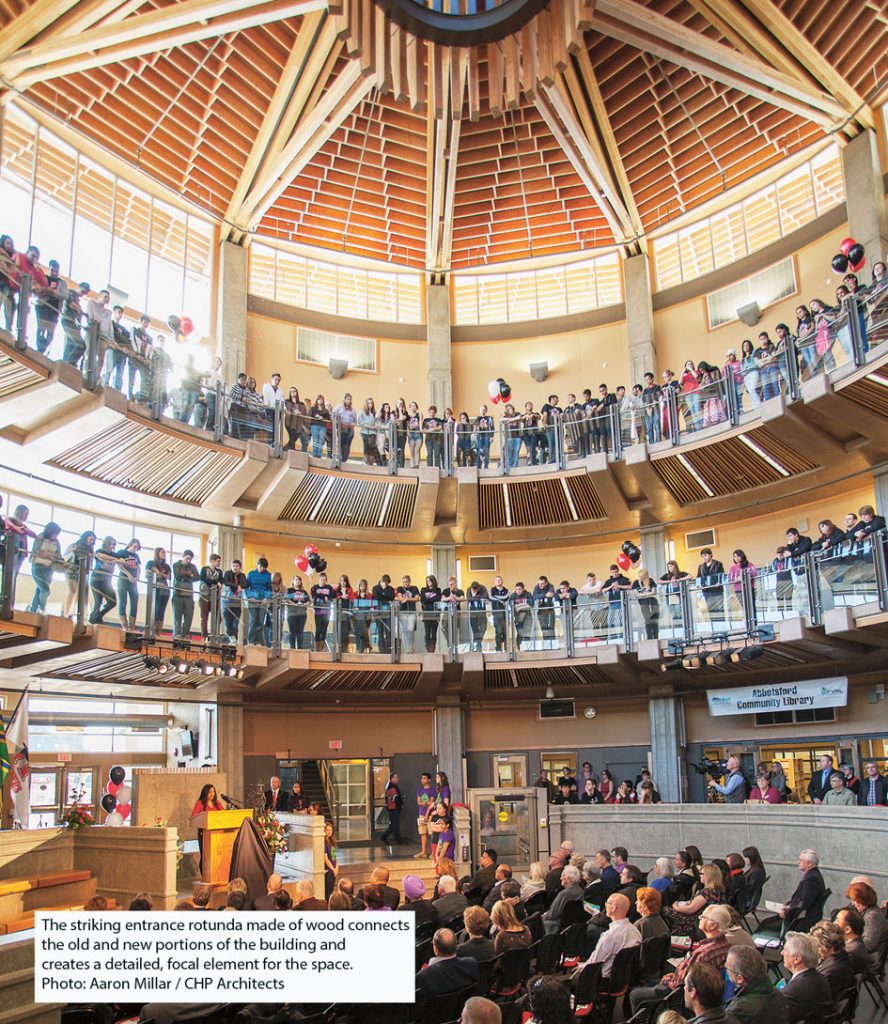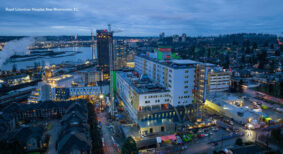Located seventy kilometres east of Vancouver in the Fraser Valley, Abbotsford Senior Secondary School features wood as part of a major rehabilitation and replacement project.
Central to its design, and crowning the school’s three-storey structure, is an intricate and impressive timber rotunda roof built of exposed glue-laminated timber and wood decking. School principal and educator Rob Comeau shares how wood is making the school a place where students feel at home, whether they’re enjoying a piano concert in the rotunda or getting hands-on experience building a tiny wood house as part of their green technology program.
Q: Why did you pursue a career in education?
A: I was born and raised in Alberta on a farm. I did my undergrad in agriculture and came out at the wrong time to be a farmer and rancher in the early 1980s. I went to my second love, which was teaching.
Q: Describe your connection to wood as a building material.
A: When working on the farm, wood was a tool. It was a fence post, it was a crossbeam, it was the outside of a grain bin. It was simply functional. On the farm, it wasn’t meant to create an emotion, but here in B.C. you see the craftsmanship that people can put into the design of a building and how beautiful wood can look.
Q: What makes a school well designed?
A: Open spaces and light are some of the best design qualities in a school. If you’re in a dark, dingy cubicle, you’re not feeling very good about where you are. When you can see light and the natural craftsmanship of wood that exists here, those are good design features. That’s B.C. architecture—light, wood, and space.
Q: Abbotsford Senior Secondary School underwent a major rehabilitation and replacement project. Can you elaborate on how wood was used in the structural and finishing components?
A: It’s a blend of old meets new and it’s done in a classy way. When you walk in, you’re immediately drawn to the grandeur of the rotunda. There are some very interesting design pieces that catch your eye when you come in. Aesthetically, wood is beautiful, and it speaks to who we are as British Columbians.
Q: How did the new design of the school reuse some of the existing wood from the original structure?
A: When they took the ceiling out, they found beautiful rafters. They looked at them and they said, “We can’t destroy this.” We’ve exposed those rafters, stained them, and it is the most gorgeous, inviting gym that you’d ever want to walk into. And some of the older parents still recognize the wood from beams we’ve repurposed as seats in our rotunda. It’s a conversation starter of their memories and time in the school. Now our international baccalaureate business class is going to open up a coffee shop and we’re going to take those remaining reclaimed beams and make them into the countertops and high-top tables— refashioning that wood one more time to create another wonderful part of the building. Wood has a way of speaking to you, years, even decades later.

Q: Research is demonstrating that the visual presence of wood indoors can significantly reduce stress levels. Do you experience this in your school?
A: I think you definitely feel better once you’ve been in a space that incorporates wood. It clears your head. We often have students that just come to the rotunda to be there, enjoy the space, and hang out. It’s open and the wood beams are beautiful and inviting. I think it helps with anxiety.
Q: What other benefits do you think the wood and architecture provide?
A: The acoustics in the rotunda are pretty amazing. We recently had an assembly with a baby grand piano in the middle of the rotunda and it was a rich, concert-hall kind of sound in there. I don’t think it was necessarily designed to be an acoustic hall but it’s certainly a richer sound than you would ever get in a gymnasium. Also, any time you can get quality product right in your backyard, why not use it? It creates jobs in B.C. all throughout the forest industry.
Q: How is wood contributing to sustainability and environmental stewardship at your school?
A: Each of us needs to adjust our carbon footprint and as a naturally renewable material, wood has a role to play. We also have a green technology program for students, along with our own wood program, and this year we’re going to be building a tiny house, constructed of local wood.
Q: How is wood part of our cultural identity as British Columbians?
A: There’s nothing more majestic than a cedar tree and witnessing what an artist can make out of that. We have First Nations carvers come in every couple of years and do a piece for us. The carvers speak about the cultural aspects of the piece they’re working on and what it means. The students get an opportunity to watch them carve and also be able to learn how to carve. We have a totem pole right at the front of the heritage room and a few other commissioned pieces. They all tell a story, and I believe there is great value in sharing that with students, passing it on from generation to generation.
Download Naturally Wood digital copy here.










